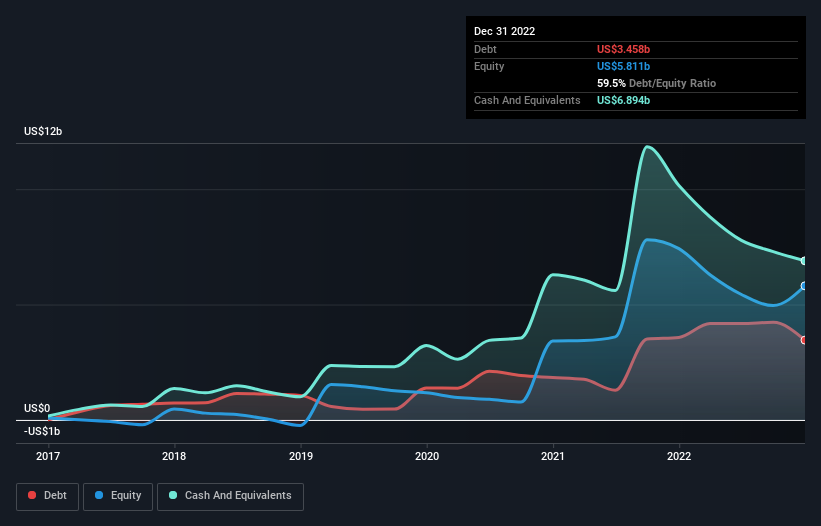Is Sea (NYSE:SE) A Risky Investment?
Legendary fund manager Li Lu (who Charlie Munger backed) once said, 'The biggest investment risk is not the volatility of prices, but whether you will suffer a permanent loss of capital.' It's only natural to consider a company's balance sheet when you examine how risky it is, since debt is often involved when a business collapses. We note that Sea Limited (NYSE:SE) does have debt on its balance sheet. But is this debt a concern to shareholders?
Why Does Debt Bring Risk?
Debt assists a business until the business has trouble paying it off, either with new capital or with free cash flow. Ultimately, if the company can't fulfill its legal obligations to repay debt, shareholders could walk away with nothing. However, a more frequent (but still costly) occurrence is where a company must issue shares at bargain-basement prices, permanently diluting shareholders, just to shore up its balance sheet. Having said that, the most common situation is where a company manages its debt reasonably well - and to its own advantage. The first thing to do when considering how much debt a business uses is to look at its cash and debt together.
Check out our latest analysis for Sea
What Is Sea's Net Debt?
The chart below, which you can click on for greater detail, shows that Sea had US$3.46b in debt in December 2022; about the same as the year before. However, its balance sheet shows it holds US$6.89b in cash, so it actually has US$3.44b net cash.
How Healthy Is Sea's Balance Sheet?
The latest balance sheet data shows that Sea had liabilities of US$6.94b due within a year, and liabilities of US$4.26b falling due after that. On the other hand, it had cash of US$6.89b and US$2.34b worth of receivables due within a year. So its liabilities total US$1.96b more than the combination of its cash and short-term receivables.
Given Sea has a humongous market capitalization of US$46.3b, it's hard to believe these liabilities pose much threat. But there are sufficient liabilities that we would certainly recommend shareholders continue to monitor the balance sheet, going forward. While it does have liabilities worth noting, Sea also has more cash than debt, so we're pretty confident it can manage its debt safely. The balance sheet is clearly the area to focus on when you are analysing debt. But it is future earnings, more than anything, that will determine Sea's ability to maintain a healthy balance sheet going forward. So if you want to see what the professionals think, you might find this free report on analyst profit forecasts to be interesting.
In the last year Sea wasn't profitable at an EBIT level, but managed to grow its revenue by 25%, to US$12b. With any luck the company will be able to grow its way to profitability.
So How Risky Is Sea?
Statistically speaking companies that lose money are riskier than those that make money. And the fact is that over the last twelve months Sea lost money at the earnings before interest and tax (EBIT) line. Indeed, in that time it burnt through US$2.0b of cash and made a loss of US$1.7b. But the saving grace is the US$3.44b on the balance sheet. That kitty means the company can keep spending for growth for at least two years, at current rates. With very solid revenue growth in the last year, Sea may be on a path to profitability. Pre-profit companies are often risky, but they can also offer great rewards. For riskier companies like Sea I always like to keep an eye on the long term profit and revenue trends. Fortunately, you can click to see our interactive graph of its profit, revenue, and operating cashflow.
If, after all that, you're more interested in a fast growing company with a rock-solid balance sheet, then check out our list of net cash growth stocks without delay.
Have feedback on this article? Concerned about the content? Get in touch with us directly. Alternatively, email editorial-team (at) simplywallst.com.
This article by Simply Wall St is general in nature. We provide commentary based on historical data and analyst forecasts only using an unbiased methodology and our articles are not intended to be financial advice. It does not constitute a recommendation to buy or sell any stock, and does not take account of your objectives, or your financial situation. We aim to bring you long-term focused analysis driven by fundamental data. Note that our analysis may not factor in the latest price-sensitive company announcements or qualitative material. Simply Wall St has no position in any stocks mentioned.
Join A Paid User Research Session
You’ll receive a US$30 Amazon Gift card for 1 hour of your time while helping us build better investing tools for the individual investors like yourself. Sign up here

 Yahoo Finance
Yahoo Finance 
